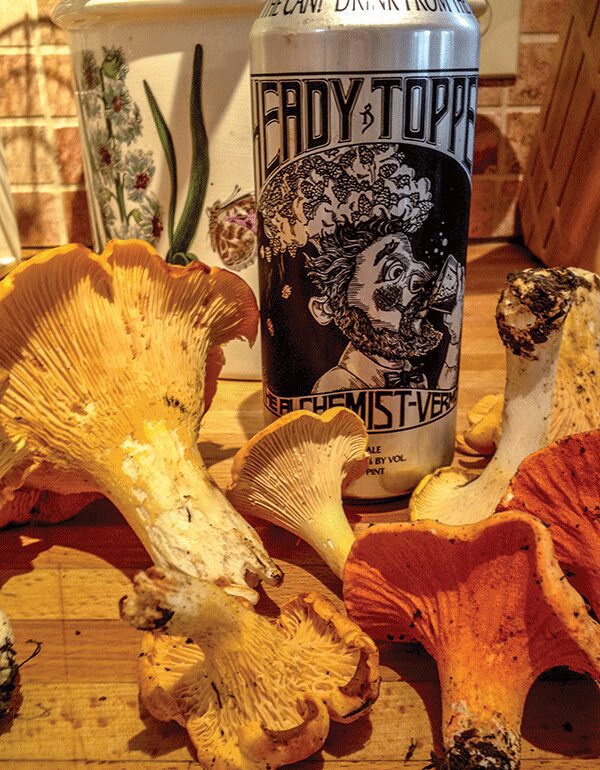Finding wild edibles in the Green Mountains
From the top of Mt. Ellen, down 3,500 vertical feet through the foothills to the fertile Mad River floodplain, the Valley is blessed with a wide range of habitats: hardwood and evergreen forests, open grassy fields, quaint villages, and even a small island of alpine tundra (on Mount Abe). This makes it excellent territory for a delicious array of wild edibles. They can be found all over the Mad River Valley, but the most favorable terrain is disturbed land (developed areas, farms, managed forests) at lower elevations.
The main season runs from spring to late fall, depending on weather and location (the Valley encompasses several climate zones, ranging from 3b to 5b). Spring edibles kick off with favorites like ramps, fiddleheads, and occasionally morels. After a long winter, these wild foods taste so fresh and full of life—as much spiritual sustenance as actual food. Through summer and fall, searchers can find a variety of fruits, vegetables, nuts, and fungi.
Foraging requires a deep knowledge of local plants and habitats. There are a range of good reference websites and local guides, but two books to start with are The Foraging New England Falcon Guide and the Audubon Society’s Field Guide to Mushrooms. If you go out foraging, avoid endangered and sensitive species (and keep in mind that animals may rely on the resources you’re harvesting). Certain species should be harvested only lightly. Others, like dandelions, are in no danger of overharvest. But whatever you’re foraging, to be safe, always positively identify what you plan to eat, and then prepare and cook it properly.
(Foraging is generally allowed without a special-use permit in the Green Mountain National Forest, as long as you’re not trying to sell what you find. Check at a local ranger station for specific requirements.)
Ramps (Allium tricoccum)
Ramps are in the onion family and simple to identify, with a strong, familiar aroma. Aside from the roots and outer skin, the entire plant is edible.
Ramps grow in clusters in fertile low areas. Among the first spring plants, they are easy to spot, once you’re aware of their leaf shape and habitat. Nearly every flowing stream in the Valley has colonies of ramps near its banks. (The Abenaki named the Winooski River—also called the Onion River—after the wild ramps growing beside it.)
You can remove individual clusters with a small garden pick. Leave hillside patches alone—they are especially fragile. Pick lightly everywhere else, since ramps are easily overharvested (they are already protected in Quebec).
The lightest way to harvest is to pick only one leaf from each plant, leaving the other leaf.
Fiddleheads, or Ostrich Fern (Matteuccia struthiopteris)
Most ferns unfurl from a fiddlehead shape. We typically eat the ostrich fern, which prefers growing on riverbanks throughout the Mad River Valley watershed and sprouts in early spring. This species forms dense mats and can be resistant to flooding, and is therefore integral to the health of the local streams and rivers.
Take few, leave many. The easiest way to find ostrich ferns is in summer, when they reach almost six feet tall. Go back to the same spot the following spring and look for well-curled fiddleheads with a brownish parchment-like covering.
Wash the covering off and then thoroughly cook fiddleheads to break down toxins. Use caution when picking—some species of fern contain carcinogens. Fiddleheads can be used like asparagus, with a similar, though less intense, flavor. They don’t have the distinctive bodily effect of asparagus, either.
Japanese Knotweed (Fallopia japonica)
Look for short narrow shoots in bamboo-like patches along riverbanks in early spring. (The taller, wider ones become woody and exceedingly sour.) They can be cooked like asparagus or rhubarb. Pick knotweed all you want, but be careful not to drop even small pieces; this invasive plant readily roots and grows anywhere, crowding out important native species (including riverbank stabilizers like ostrich ferns).
Sauté or grill the tender shoots with soy sauce or oil and garlic. The savory sauce and mildly sour knotweed create a surprisingly good nutty, lemony blend. Prepare larger shoots as you would rhubarb, cooking longer to break down fibers and adding a little sugar to balance the sour taste.
Chanterelles (Cantharellus cibarius)
The Mad River Valley is home to several excellent edible fungi, including oysters, puffballs, lobsters, chicken of the woods, and king boletes, but our most famous are chanterelles. These beautiful mushrooms can be abundant in the proper conditions. They tend to start in late June and run to late September. Look under piney stands from the floodplain up to about 1,500 feet in elevation. Be sure to learn to differentiate the chanterelle’s main poisonous lookalike, the jack-o’-lantern (Omphalotus olearius). Cook before eating. My favorite way is to sauté them with butter until they get almost crispy.
Beech (Fagus grandifolia)
Beech nuts are produced by mature beech trees (at least forty years old) in the fall, though not necessarily every year. The smooth gray bark is the easiest way to identify the trees; look on the ground underneath them in autumn to find the nuts. Many animals eat beech nuts, including mice, turkeys, fox, deer, opossums, black bears, and porcupines.
The nuts are small, moderately bitter, and hard to extract, but they have many potential uses: they can be crushed into a butter, added to breads, or used as an accent to sauces. Roast the whole nut and then remove the husk before cooking or eating the meat. Boiling can help reduce bitterness.
Young, soft spring beech leaves are also a tasty edible. You can eat them raw or cooked like spinach. The flavor is sweet and mildly minty. The species name, Fagus, comes from fagito, meaning “to eat” in Greek, so apparently beech leaves and nuts have long been thought of as a food source, even if that tradition has mainly been forgotten in the U.S.


